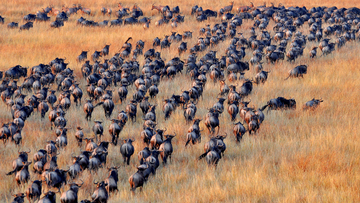The Serengeti-Maasai Mara migration is a breathtaking natural phenomenon that captivates the world. Yet, beyond the thundering hooves of wildebeests and the primal struggle for survival, this awe-inspiring event creates vibrant cultural interactions with the indigenous communities that inhabit the Tanzanian and Kenyan landscapes. In this blog, we unfold profound cultural interplay between the Serengeti-Maasai Mara migration and indigenous communities – from Sambaa and Chaga's agricultural harmony in Tanzania to Hadzabe's enduring hunter-gatherer bond and the Maasai for their nomadic lifestyle across Kenya's plains and their resourceful adaptation involving beadwork crafts – that call this region home.
Agricultural Symbiosis of the Sambaa and Chaga Communities with the Wildebeest Migration
Within Tanzania's fertile landscapes, the Sambaa and Chaga communities have interwoven their agricultural practices with the wildebeest migration, creating a remarkable symbiosis between human cultivation and the natural rhythm of this annual phenomenon.
For these communities, the migration of wildebeests isn't merely a passive observation; it's a dynamic element that profoundly influences their agricultural activities. The migration acts as a calendar, offering cues and insights into the optimal timing for various farming tasks. As the wildebeests journey through the region, their movements mirror the cycles of the land, signaling shifts in climate, grass growth, and water availability – all critical factors that impact successful farming.
When the wildebeests arrive, they graze on the abundant grasses, trimming the landscape in a pattern that mirrors the natural flow of the ecosystem. This grazing, in turn, rejuvenates the soil, enriching it with nutrients and organic matter. The Sambaa and Chaga people have learned to observe and interpret these movements, using them as a guide for when to till, plant, irrigate, and harvest. By aligning their agricultural practices with the migration's rhythms, they ensure that their efforts are in harmony with the land's natural cycles, optimizing their yields and fostering a sustainable relationship with their environment.
Furthermore, the migration isn't just a practical guide; it's a source of inspiration and cultural significance. The migration's annual return reinforces a sense of continuity and tradition among the Sambaa and Chaga communities. As they work the land, they are reminded of their connection to both their ancestors, who also relied on these cues, and the enduring cycles of nature. This interaction between the wildebeest migration and agriculture creates a context where ancient wisdom and the wild's unpredictable beauty enrich both the community and the ecosystem.

Women from the Sambaa community, and men from the Chaga community.
Source: https://www.bramwelsafaris.com / www.mrowl.comHadzabe: Migration's Hunter-Gatherer Harmony
The Hadzabe people from Tanzania offer a great insight into humanity's historical bond with the natural world. Their hunter-gatherer way of life is closely woven into the fabric of the wildebeest migration, creating a dance where survival, tradition, and the patterns of nature seamlessly intertwine.
Drawing upon ancestral knowledge passed down through generations, the Hadzabe rely on the wildebeest migration as a guiding force for their hunting and gathering practices. The migratory patterns of wildebeests serve as a roadmap, signaling the availability of resources and the optimal time to pursue game and gather edible plants.
As the wildebeests traverse the landscapes, they shape the Hadzabe's movements, effectively influencing the course of their daily lives. The migration's natural patterns dictate when and where the Hadzabe set out on their journeys. By interpreting these movements, the Hadzabe align their actions with nature's guidance, ensuring their survival and strengthening the relationship that has persisted over time.
In essence, the Hadzabe's existence is linked to the wildebeest migration, where nature's patterns dictate the flow of their daily endeavors.

A man from the Hadzabe tribe teaching young boys how to hunt.
Source: www.exploring-africa.com
The Maasai: A Symbiotic Blend of Nomadic Life, Beadwork Crafts, and the Wildebeest Migration.
The Maasai people span the Serengeti plains of Tanzania and the rolling landscapes of Kenya's Maasai Mara. The nomadic lifestyle of the Maasai relies deeply on the wildebeest migration, playing a pivotal role in shaping their movements, resource utilization, and overall survival strategies.
As nomads, the Maasai depend on the availability of water, food, and suitable grazing areas for their cattle. The wildebeest migration directly influences the distribution of these crucial resources. The movement of the wildebeests triggers a chain reaction across the ecosystem, affecting the availability of fresh grasses and water sources. The Maasai have developed the ability to interpret these signals, utilizing the migration's patterns as a guide for their own journeys. By strategically following the migration's path, they ensure access to essential resources, allowing their livestock to graze and thrive in sync with nature's cycles.
Furthermore, the Maasai have embraced beadwork crafts as a cultural adaptation, creating meaningful pieces that attract tourists visiting their villages to witness the wildebeest migration. These beautifully crafted beadwork items not only preserve their heritage but also serve as a vital source of income, diversifying their economy and enhancing their resilience against challenges, all while maintaining the core essence of their nomadic identity.
In essence, the wildebeest migration acts as a guiding force, directing the Maasai's movement, resource management, and food procurement. This interdependence underscores the Maasai's profound understanding of their environment and their skill in adapting their nomadic lifestyle to the natural world's patterns.

A Maasai man guiding a cow in search of green pastures.
Conclusion
The Serengeti-Maasai Mara migration is not merely a natural spectacle; it is a symphony of cultures and ecosystems that resonates across time. The Sambaa and Chaga communities, the Hadzabe people from Tanzania, and the Maasai people share a close bond with the wildebeest migration, which significantly supports their agricultural practices, hunting-gathering traditions, and nomadic way of life respectively. As we appreciate the roles this migration plays, we come to understand the vital connection that nurtures their distinct lifestyles and enriches their cultural identities. Reflecting on these dependencies, we celebrate the enduring relationship between these communities and the wildebeest migration – a partnership that continues to shape their narratives and resonate throughout African history.






